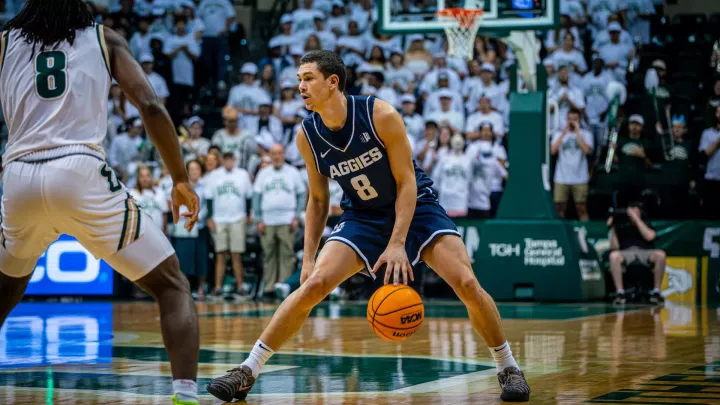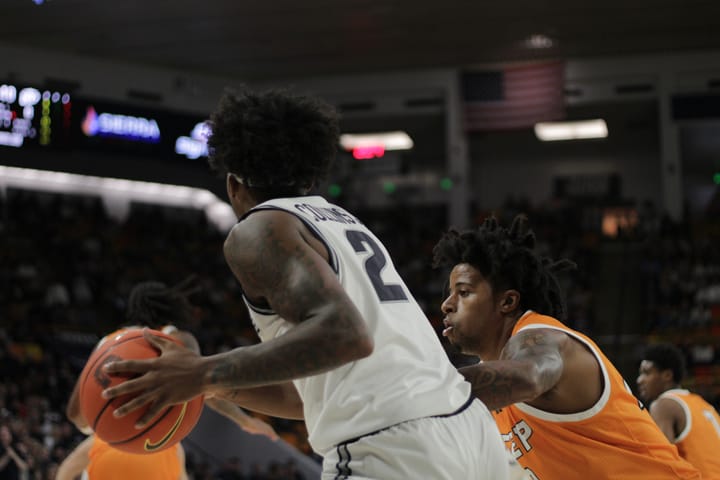MBB Game Notebook: Aggies Showcase Depth In Exhibition Victory
Can I interest any of you in an enormous, free game notebook on Utah State's exhibition win over Seattle? I certainly hope so, because here it is. Game Notebook:
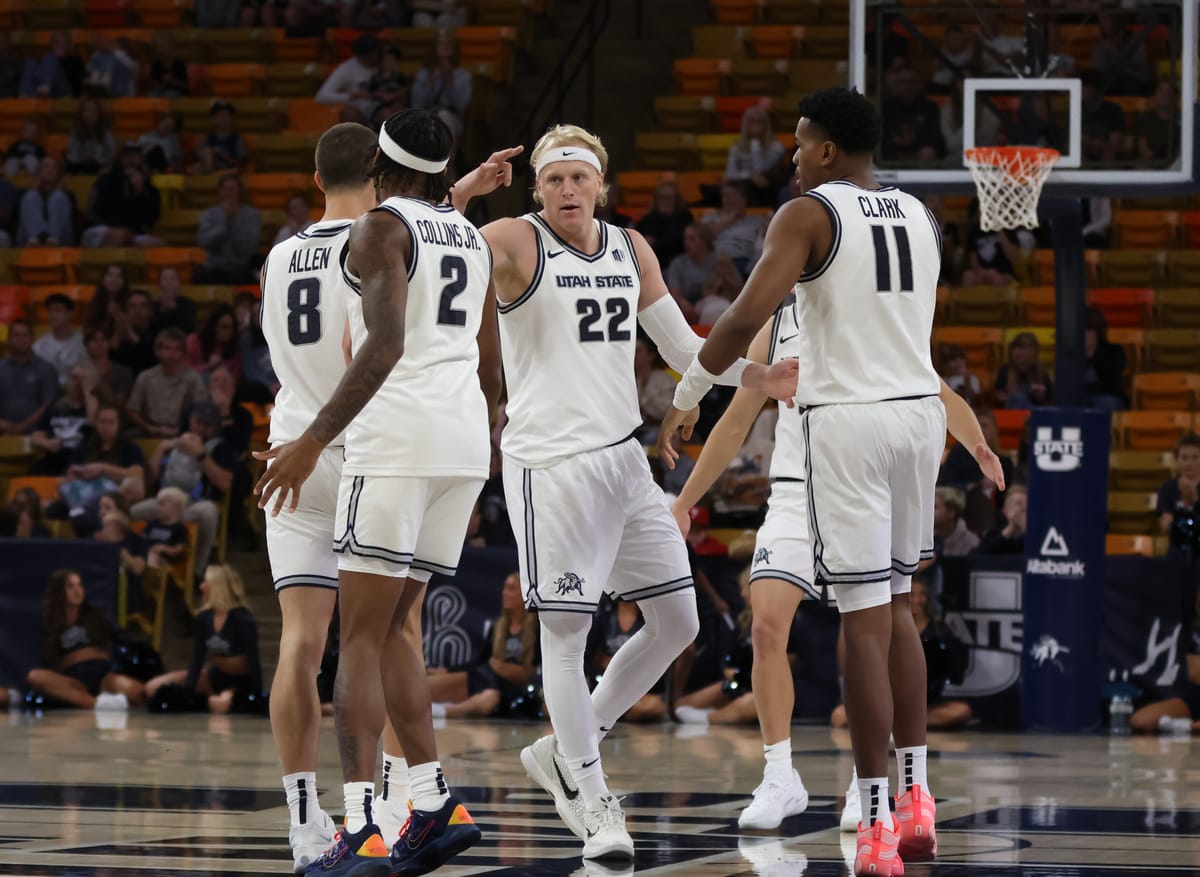
Notes, quotes, thoughts and other quick hitters from Utah State's 88-76 exhibition game win over Seattle. Let's not waste any time.
How It Happened
Utah State made clear only a few minutes into its Oct. 18 exhibition against Seattle that the visiting side would not be particularly important in determining the outcome.
That's not to slight the Redhawks. Head coach Chris Victor seems to have built another solid WCC squad, checking in this season at No. 117 in KenPom's preseason rankings with a serious chance to hit the 20-win mark for the fourth time since he arrived in 2021-22. They have real talent at their disposal – sophomore forward Will Heimbrodt recorded a game-high 23 points with six rebounds, guards Maleek Arington, John Christofilis and Brayden Maldonado all started for Seattle last year, and the transfer portal provided potential frontcourt standouts in Southern Utah's Brock Felder, Grand Canyon's Austin Maurer and Gonzaga's Jun Seok Yeo.
Jerrod Calhoun simply has far, far more of it as he enters his second year at the helm in Logan. Some of that talent is, at this point, familiar. Utah State deployed a trio of incumbents in its starting lineup and picked up 37 combined points, 15 rebounds, 15 assists and eight steals from its five-man returning core of Drake Allen, Tucker Anderson, Jordy Barnes, Mason Falslev and Karson Templin. Anderson (11 points), Falslev (10) and Templin (11) all ended the game in double figures, while Allen led the team with six assists and Templin did the same with six rebounds.
Another third of Utah State's 15-man group joined the program this offseason by way of another DI school. Vanderbilt transfer MJ Collins led that contingent with a team-best 15 points, plus three steals, two assists and a rebound, but he was not alone in impacting the game. Two-time all-Southland forward Garry Clark had seven points, two assists and a rebound; former Utah big man Zach Keller chipped in five points and four rebounds in just 10 minutes; Butler guard Kolby King added 11 points and a board; and Air Force wing Luke Kearney served this time as the unfortunate odd man out, starting cold and never finding his way onto the scoreboard in seven minutes of action.
The oft-touted freshman class, occupying the last five spots on this Aggie roster, involved itself as well – though only wing man Adlan Elamin (one rebound, one assist, one block) and guard Elijah Perryman (seven points, two rebounds, one assist and a block) logged more than 10 minutes in the outing. But they all played, which speaks to the larger point: This was a chance for Utah State to wield its considerable collection of skill, speed and size against someone else for a change. It was a test run for the real thing, which is somehow less than two weeks away, conducted in what could be technically considered an uncontrolled environment.
"I tip the hat to Seattle for coming here to play us," Calhoun said. "I thought it was a neat environment and a great opportunity for us to get better, play against a good-quality team and raise some money for the future. I want to thank all of the fans that purchased the tickets. College sports have certainly changed and we as a university have to continue to strive forward and make those changes in this revenue-sharing model that we're all going by. I really want to thank all of the people who purchased tickets. There were many people who purchased them that didn't come to the game. It was really a win-win today, I thought."
Whether it was truly uncontrolled or not depended largely on Calhoun's tolerance for lineup experimentation, which rose and fell with the margin on the scoreboard.
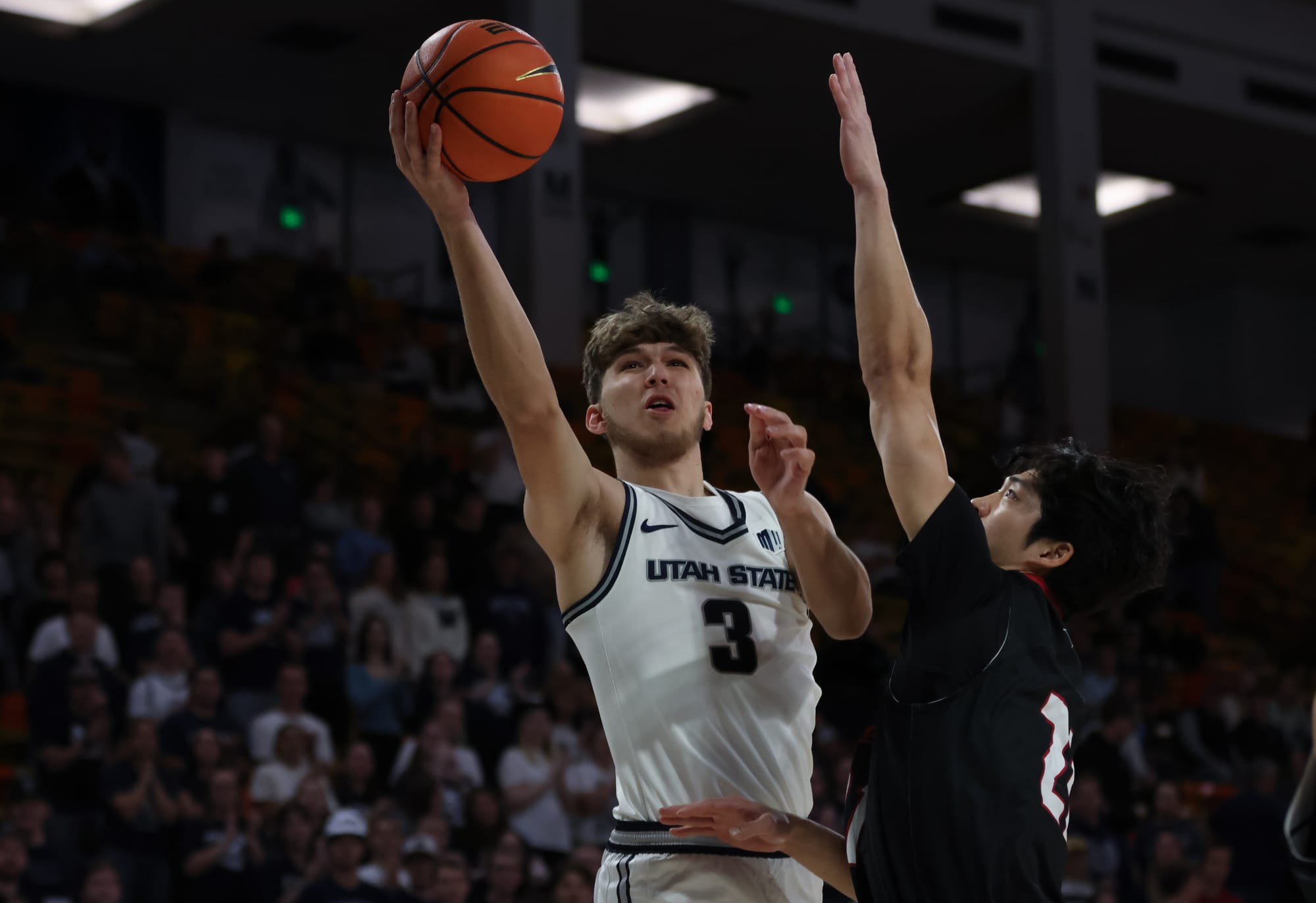
Utah State opened the afternoon with a reasonably plausible (and still yet to be truly solidified) starting five of Allen, Collins, Falslev, Anderson and Keller, which turned in a sloppy but decently productive three-minute shift. Anderson wasted no time showing off his newfound confidence in the lane, bolstered by an offseason spent bulking up from 210 to 230 pounds, and kicked off the scoring with back-to-back driving finishes through contact. He stuck to that approach for most of the game, taking (and making) only one three-pointer while converting on 4 of 5 shots from two-point range.
"You just don't want to be a one-trick pony," Calhoun said. "I thought last year (Tucker) didn't mix it up at all. He went up about three weight classes. Tuck could have gone into the portal. He could have bailed like 75, 80 percent of kids do. They transfer, they have a bad season and then they try to find the next school. Tuck didn't do that. He said, 'Let me find the weight room.' Let's find the weight room, go gain 20 pounds, and you saw it in his play. He finishes around the rim better, he's more comfortable crashing the glass and finishing around the basket. I think he'll get better and better."
A traveling violation from Collins, who was a bit too eager to start a fast break after nabbing a defensive rebound, set Seattle up for its first basket, though Allen quickly answered that on the other end with a tip-in following a Falslev miss. Two more Aggies turnovers following a Maldonado layup eventually brought the game even at 6-6, which Keller split with a make near the rim before subbing out alongside Anderson for Clark and Templin. That configuration finished a lot better than it started, albeit with a low bar to clear after a Collins miss from deep, a Falslev foul and a Templin turnover that Seattle parlayed into a Heimbrodt triple to take a 9-8 lead.
That lead, Seattle's only one of the game, lasted all of 21 seconds before the Aggies found their footing again, with Templin assisting on a Falslev three-pointer and Allen doing the same for Collins on the ensuing possession to force a Seattle timeout. Save for one make at the very beginning from Felder, the next three minutes conducted by a lineup of Perryman, King, Collins, Clark and Templin were firmly among Utah State's best of the day.
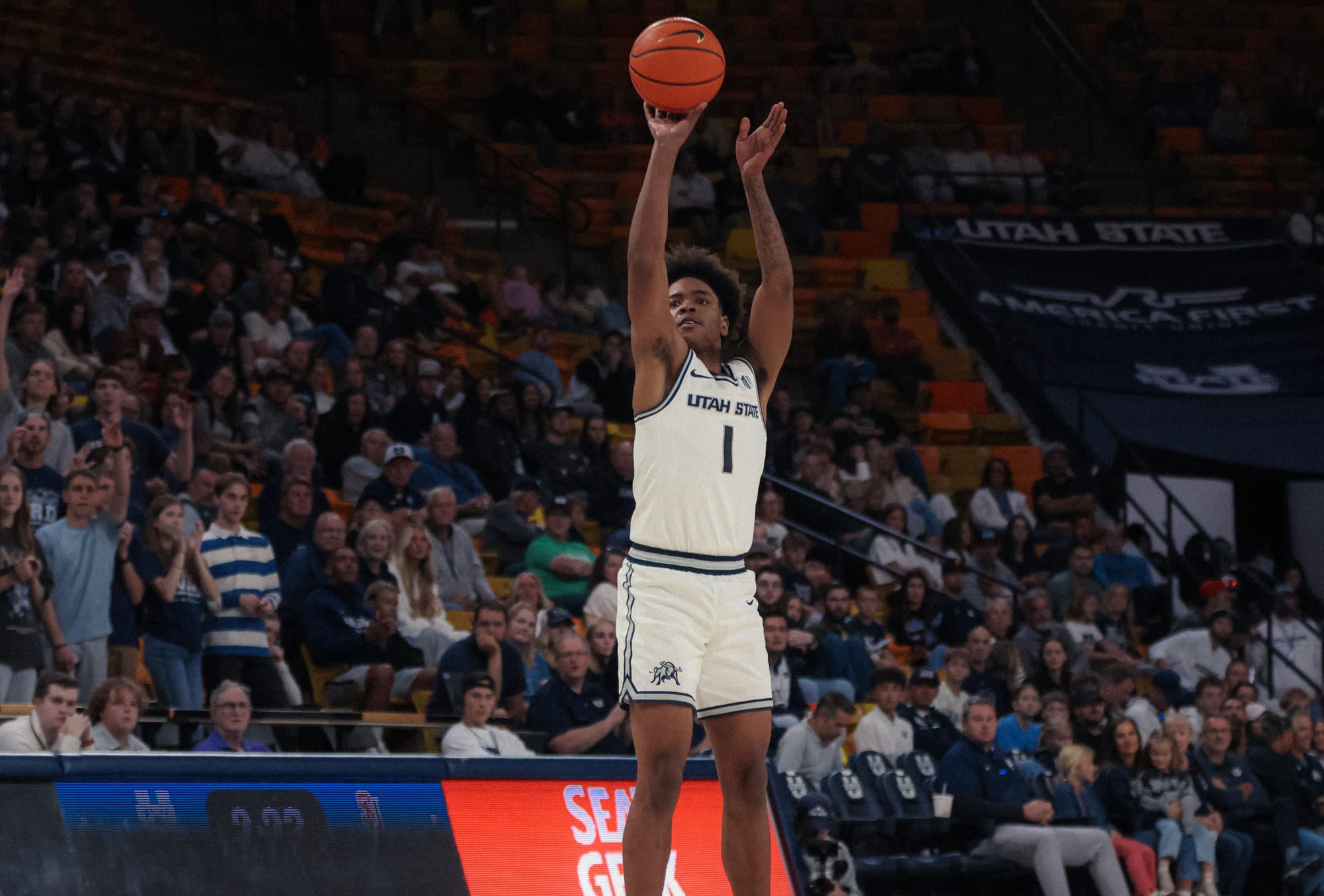
Forcing a pair of Seattle turnovers and four missed shots, all from beyond the three-point line, the Aggies ratcheted up their pace and rattled off 11 points without answer. Collins bookended the surge with a pair of fast break layups from steals he caused, Clark ripped off five quick points on a dunk (assisted by Perryman) and a three-pointer (assisted by Collins), and Templin added the other make on a paint jumper (also assisted by Collins) to help push USU into a 25-11 advantage as the game clock ticked under 12 minutes.
Feeling comfortable in that 14-point edge, Utah State's next lineup was far more speculative and far less successful. Swapping Perryman for Barnes, Collins for Kearney and Clark for Elamin initially, with Templin eventually leaving the floor as well to make room for freshman forward David Iweze, the Aggies gave back nearly all of that 11-0 run.
Seattle put nine points on the board before Utah State scored next on an Iweze putback and eventually drew within three points on consecutive triples, setting a 29-26 margin at the under-8 timeout. In response, Calhoun moved back to his original starting five, save for Collins (replaced at the time by freshman Kingston Tosi), which did the trick well enough to at least stabilize the team, resetting the difference at seven points (37-30) behind a quick flurry from Allen and Falslev.
"We kind of stuck to one team," Calhoun said. "We had a really bad lineup with the one group, but we knew that would happen because we're playing so many guys. It's really not about the score. Who really cares about what the score looks like? What does our team look like? Do we look like a team? Are we organized, disciplined, and playing together? I thought for the most part we were, but there were some really rough stretches. This group has a lot of players, we have probably two at every position."
The Aggies closed out the half with much of the same de facto second unit that had sparked the first big run, and while that group wasn't quite so dominant this time around, it too did the job asked of it. Anderson drove for another layup, Clark scored on a pretty inbound play, Perryman and Templin both connected from distance and Collins gave Utah State its last basket of the half on a mid-range jumper. A buzzer-beating Seattle layup kept the halftime difference within single digits, 49-41, in fitting fashion, coming on the heels of Utah State's eighth turnover of the frame. The Redhawks picked up 14 first-half points from those giveaways, which were a concern of Calhoun's entering the contest. Utah State ended the game with 14 total turnovers, though it did manage to limit Seattle to only four more points from those chances in the second half.
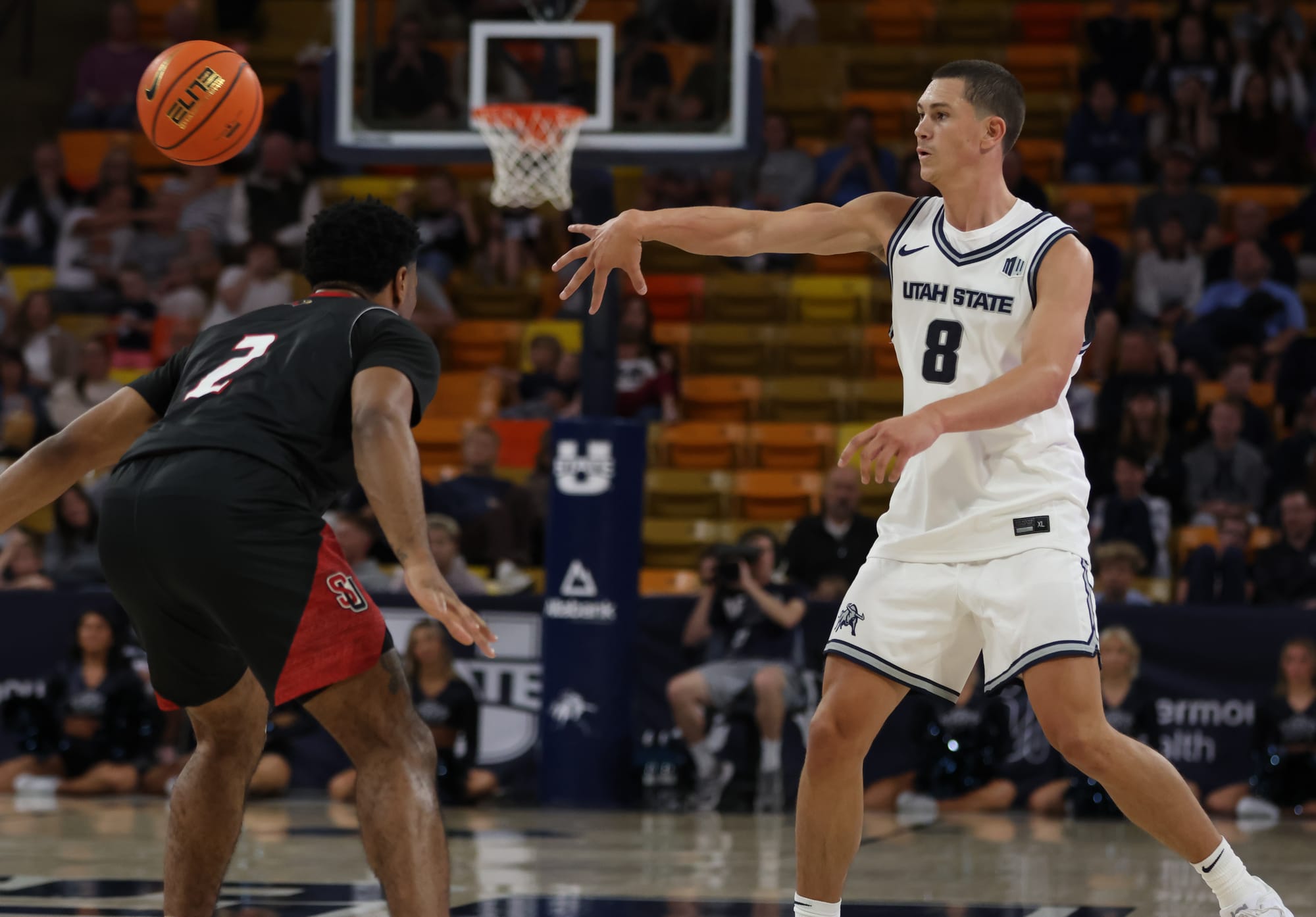
"This time of year, I think the two biggest things you're really trying to key in on are your transition defense and your ball security," Calhoun said. "It's hard to play transition defense when you don't have great ball security. We threw the ball all over the gym at times. When we don't throw it to the other team, we're pretty good. We have to understand ball security. It's a game of possessions. Everybody I talked to I think is going through the same thing. Fourteen is totally way too many turnovers. A lot of them were very careless turnovers, so we'll look at the tape.
"To be honest with you, we don't have anything in offensively. We just say, 'Play to the next advantage.' We don't have a ton of stuff. We've been doing a lot of defensive things here for really about five months. Our defense would have been excellent if we didn't throw the ball to the other team, They would have been probably in the low 60s, if that. In the first half they scored 14 points off our turnovers, they ended up with 18, so we were a little better in the second half. When our defense is set, I think it's really good. That 76 number is a little bit of a farce based on how bad we were offensively. The defense has actually been much corrected, scheme- and player-wise. We'll be a better defensive team."
If there was any point of true danger to the Aggies in the exercise, it came in the opening minutes of the second half. Utah State swapped Clark in for Keller at center and otherwise went with the same first five to begin the period, which was apparently a dire mistake – Seattle came out of the gates firing, knocking down a pair of two-pointers and back-to-back triples matched only by Anderson's lone three-pointer of the day, to cut the Aggie lead down to just a point, 52-51.
Calhoun took a timeout to remind his group that the game had restarted several minutes prior and that they were still expected to participate in it. His message got through defensively, as Seattle's hot start ceded to a 1-for-8 shooting spell spanning the next six minutes of action, but it took the Aggie offense a bit longer to reengage. Though Collins added a three-pointer of his own to Anderson's, stretching the lead back to two possessions, Utah State didn't really snap from its scoring malaise until Calhoun shook up the lineup, swapping Allen for Barnes, Falslev for King and Keller for Templin.
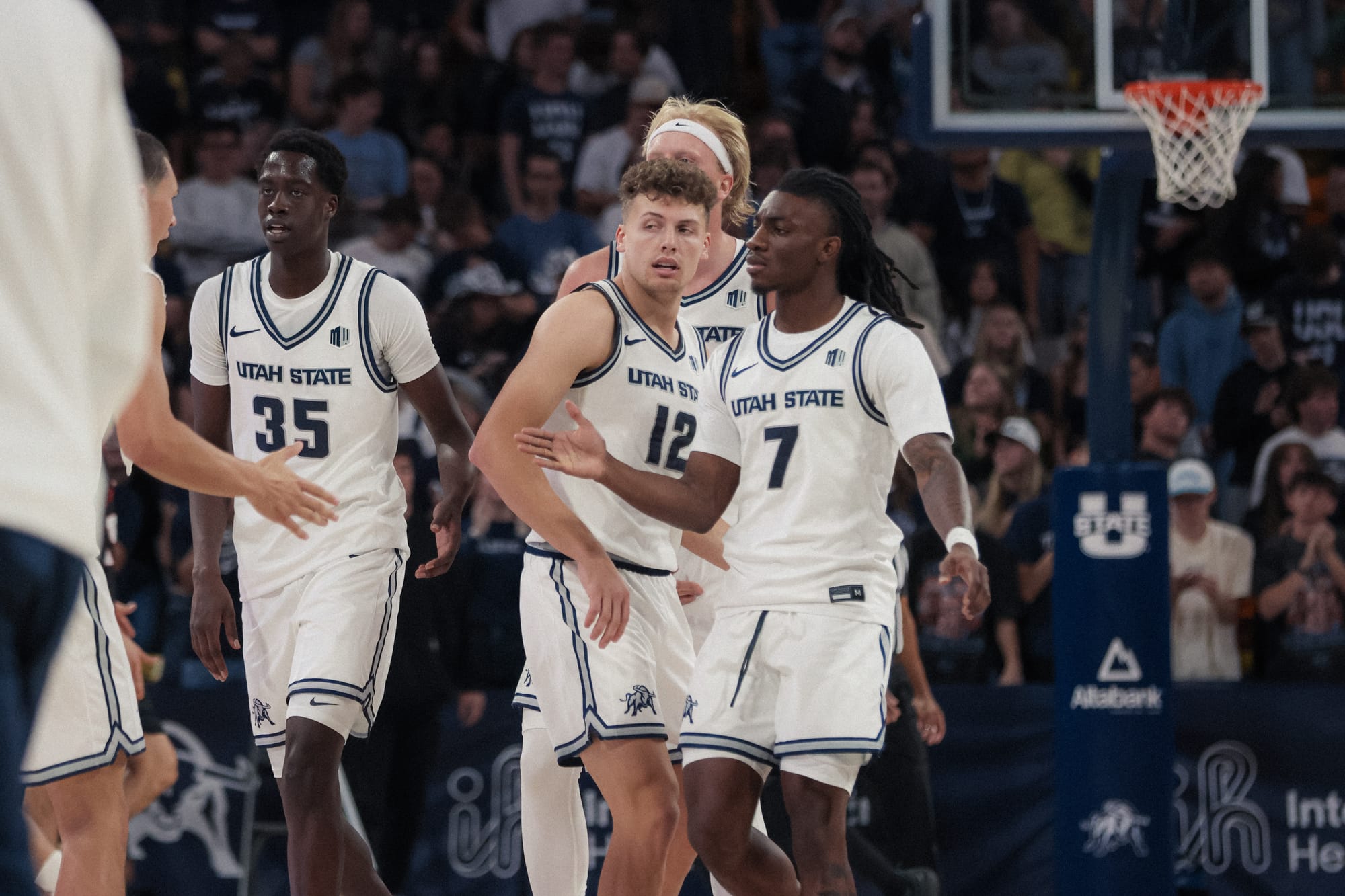
It was the Butler transfer who offered the spark in this case, as both a pestering on-ball defender and a scorer. He had struggled to involve himself in the opening period but found his way onto the scoring sheet at the 14:35 mark with a Barnes-assisted layup, knocked down three free throws on Utah State's next possession, and buried a triple not long after to give the Aggies a 63-54 cushion.
The 6-1, 185-pound senior pitched in three more free throws later in the frame to round out his 11-point day – a total he matched or exceeded only five times last season after averaging double-digits (10.4 PPG) in his lone season at Tulane in 2023-24. King's microwave scoring is not the only trait that attracted Utah State to the Pompano Beach, Florida native, but it surely didn't hurt.
"I think Kolby will get better and better too," Calhoun said. "He can fill it up. He shot 38 percent last year for Butler. If we get him, MJ, Tuck, all of our guards, Drake Allen, you can get those guys to understand that how you improve your shot numbers is not about how many you take. It's about how efficient of a shot you're taking. Kolby and MJ will get a lot of shots. Transition threes. So will Tuck and Mason. I think Kolby is still figuring it out. He's a little like Deyton Albury last year, we got him and it took him a little time to figure out and then he was a really productive player.
"These guys who are transferring, it takes them a little time. Just because you add them to your roster, it doesn't mesh right away. You have to go through some things to really figure out who these guys are and how we can help them. We're never going to turn our backs on them. We're always going to work with them, get them better, and we wanted them to play through some of the struggle today, and I thought we had a chance to do that. Also, we probably could have left some other guys out there, but we weren't going to do that. We weren't going to play guys a ton of minutes."
For the next three minutes or so, the scoreboard margin hovered around that same range, boosted by a pair of Templin two-pointers and cut back by a Miles Amos three-pointer and two Houran Dan free throws. It was another speedy, disruptive three-guard lineup of Perryman, King and Falslev that broke the rut, pushing the tempo hard and rattling off a quick 7-2 run behind two Perryman layups and those aforementioned King free throws to stake out a 13-point edge, which Keller expanded to 14 points by the under-8 break, 77-63.
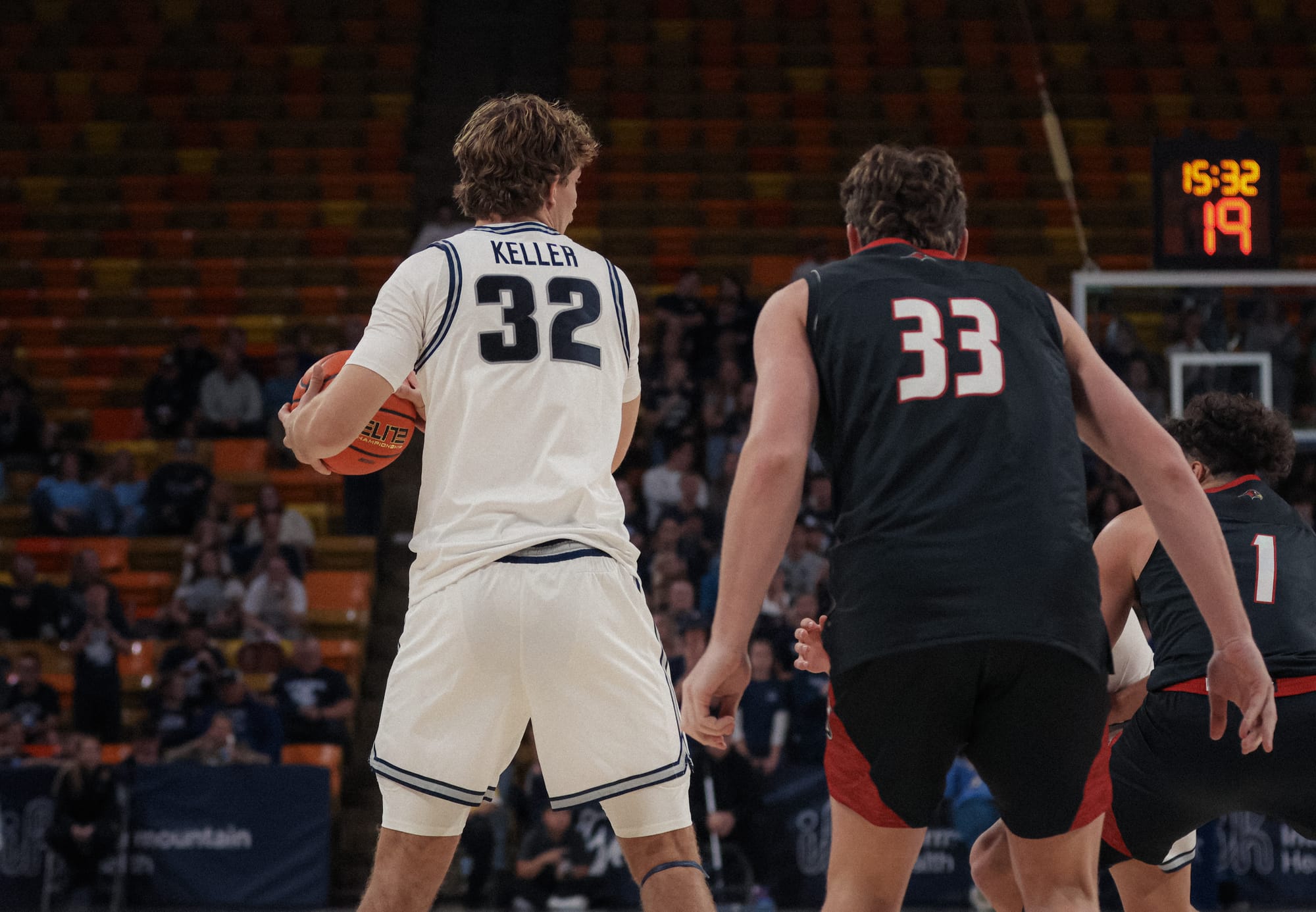
The big man from Highlands Ranch, Colorado didn't have as much time on the floor as he might've liked, but he did well to attack the basket when his chances came, as did most of the frontcourt. Utah State picked up 46 points in the paint for the game and drew 29 combined points, 13 rebounds and six assists from Clark, Iweze, Keller and Templin on 12-of-21 shooting (2 of 4 from three, 3 of 5 at the stripe).
"Garry was just okay tonight. He's been really good at practice. Zach has been really good. I think we all know what KT is capable of, he's a great player. Same thing with David Iweze. They're big and strong and they can really score around the block, but they can also play on the perimeter.
"It's about getting to the next advantage and about being unpredictable. Having your forwards understand that they're kind of the connectors of the offense. They can, at any time, go from low to high and create an advantage whether it's a screen or a catch. Now, they have to read the defense. MJ and Mason and some of our wings, they'll be denied a lot, especially when we're playing against the Aztecs and some of these teams. So, to have the ability to have these forwards see the game, that's really what we've been doing a lot of.
"Our guards dribble too much. I want to get into more chase action where we're throwing the ball. We call it a rifle, we rifle to the corner and now we can get shots or we can get chases where we're chasing the ball. But, we have no idea what we're doing offensively, to be honest with you. We're going to be good. To get 88 points when we haven't done anything, I feel pretty good about our offense."
Seattle had one more brief surge in it, capitalizing on a fatigued Utah State lineup for a 6-0 run to cut the difference down to eight points with 5:38 to play before Calhoun's next big substitution. That change, to bring Allen, Anderson and Falslev back onto the floor while Kearney, King and Perryman got a breather, ultimately proved definitive.
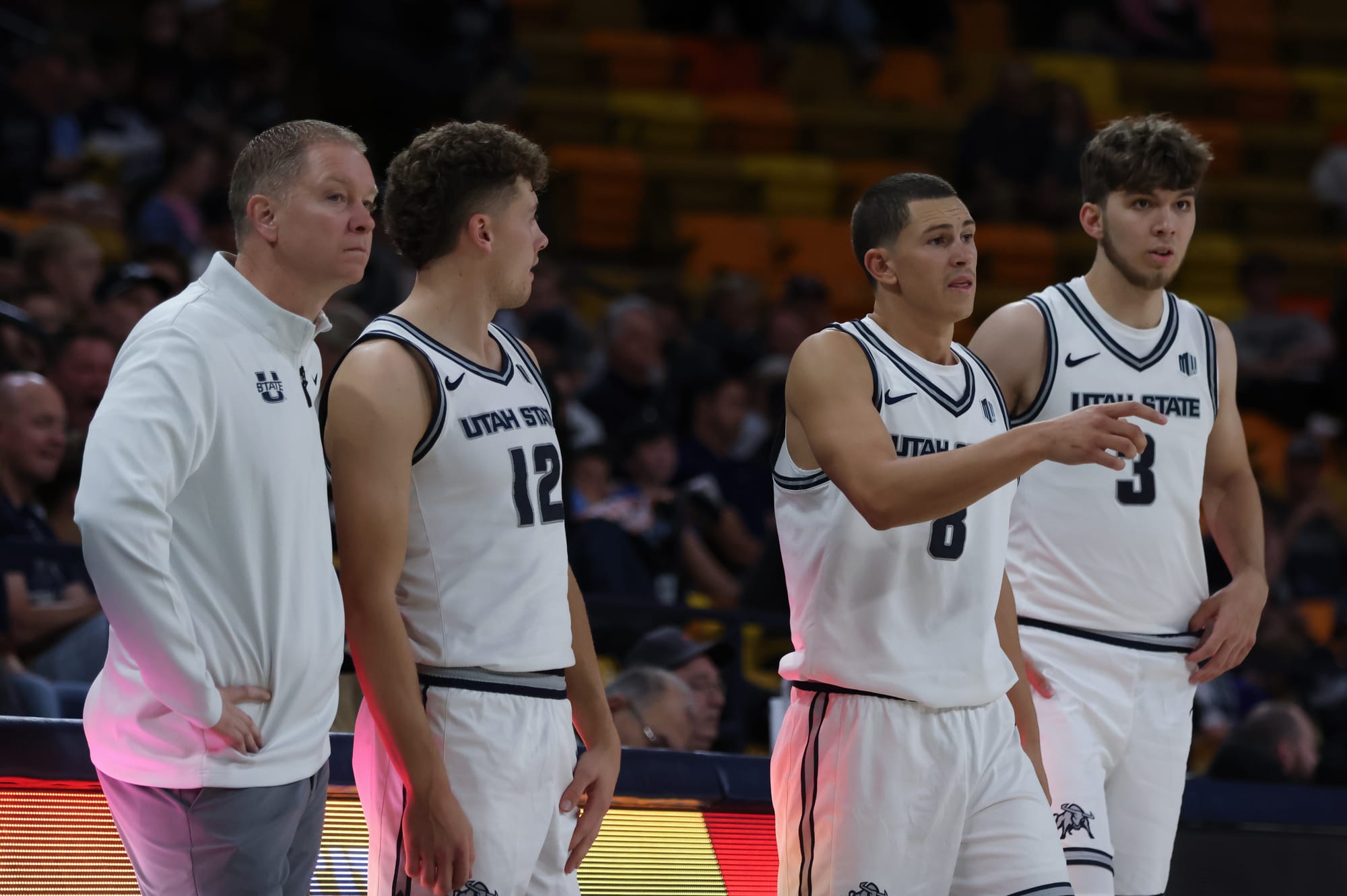
Pairing that veteran trio with Collins and Iweze (and eventually Templin), Utah State rattled off an 11-2 run capped by a Templin layup and took its largest lead of the afternoon, 88-71, into the final two minutes, where it could safely empty the bench once more. Said emptied bench did not cover itself in glory, surrendering five points and scoring none to set the final score, but it would get a shot at redemption in an extra 10-minute period that did not count toward the final stats.
More important for Utah State than the final score, or any of the stats therein, was the situational experience it gained. The Aggies faced some adversity, worked through it, and gained extremely valuable knowledge about what they still have to work on before the season arrives. That, with the new bonus of extra money for the retention and recruiting fund, is why these games exist to begin with.
"I love it," Calhoun said. "I think you can only get it in the game. You have to be able to handle success and you have to be able to handle when you fail out there. That's what sports are. There will be a lot of crazy moments… You don't get it unless you get it against some of these other teams. You can do all of the constraints at practice and all of these different things, and we've run a really hard camp. We've been hard on our guys. One thing we did a bad job of is that we have to get up and down more. Our guys looked winded I thought in that second half a little bit.
"We'll get guys better this week. It'll be a great challenge on the road against San Francisco, top-50 or top-60 team in the country, probably picked third in the WCC, and then you turn around and play Westminster and VCU the following week. We don't have time to waste, we have to go."
How It Also Happened
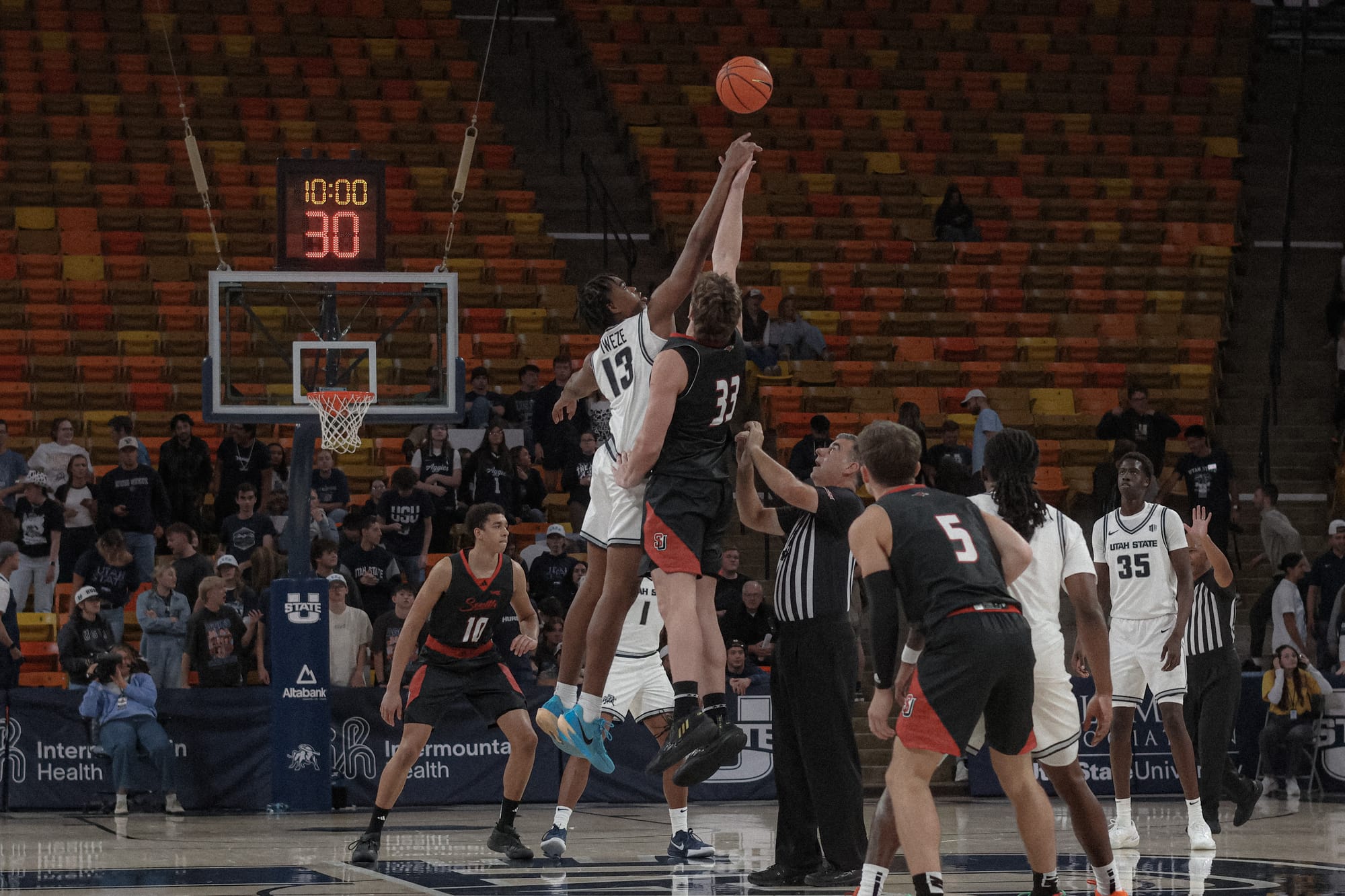
The additional 10-minute period immediately following the standard 40-minute, two-half exhibition does at least bear mentioning, albeit in less detail. This frame was about experimentation, even more than the play preceding it. Utah State opened with a lineup of Perryman, King, Tosi, Elamin and Iweze, while involving Barnes, Boe, Clark and Kearney off the bench at various points.
Unfortunately, because I am without play-by-play information for this portion of the afternoon, all we really have to go on here is my dreadful memory and a collection of stats. On the former, I remember that Utah State closed out the period with a 9-3 run, all of which came while all five freshmen were on the floor.
"It was kind of neat to see the five freshmen on the court together there at the end," Calhoun said. "We're probably one of the only schools in the country that went out and took five high school kids. Elijah at times looked really good. David Iweze was really good. Adlan's potential is through the roof. Brayden is a tough kid. And Kingston is a great player who plays off the catch, and he's a great athlete. He can attack close-outs. It was neat to see those five kids there at the end to play those minutes. It's a long year and I don't think we'll wear down, we have good depth. But, we have to keep coaching and getting better."
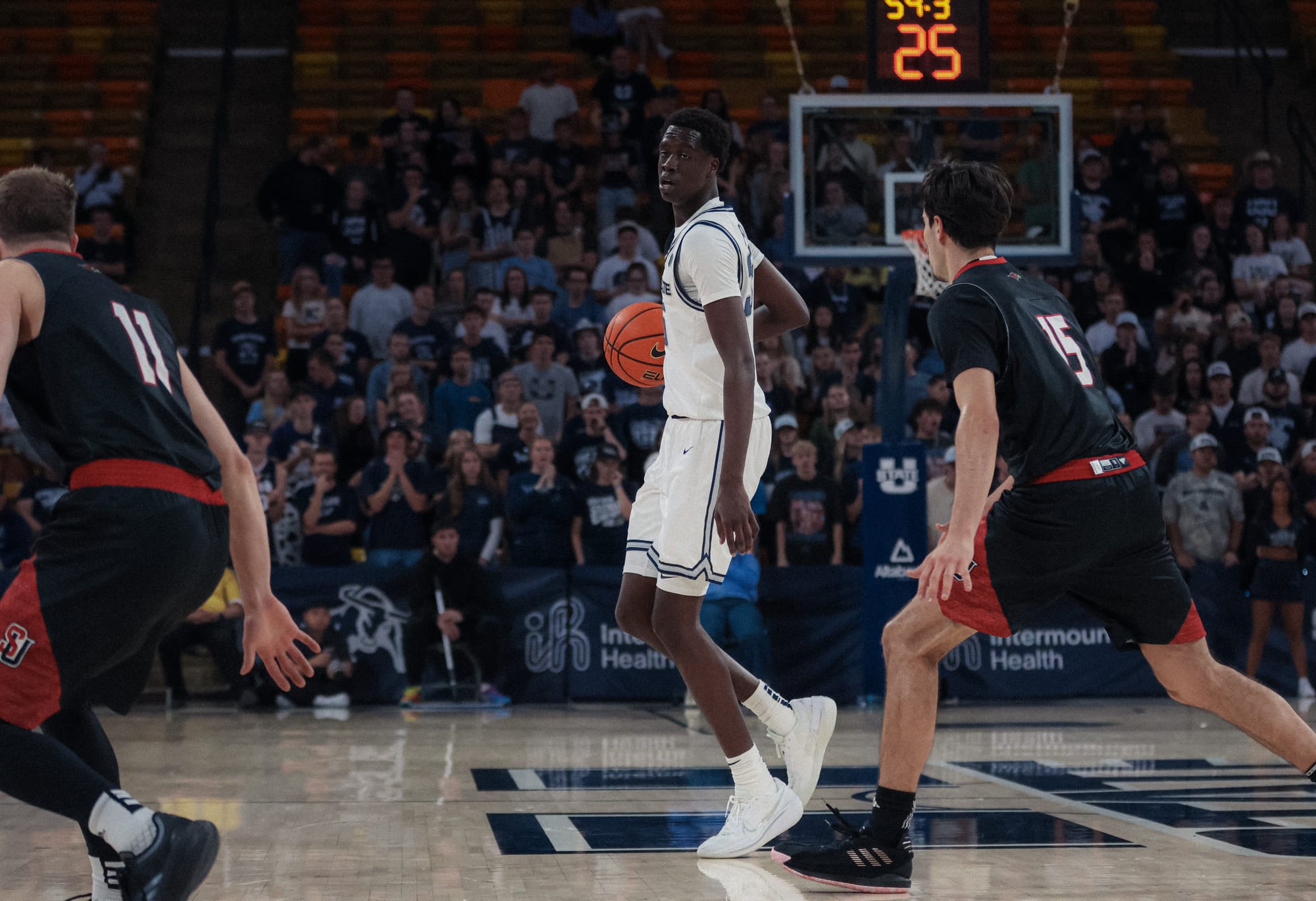
Elamin was Utah State's most productive scorer within the frame, knocking down 2 of 5 shots (1 of 4 from three) for five points while nabbing two rebounds, an assist, a steal and a block. There's still plenty of work to do for the Arlington, Virginia product, especially on the offensive end, but he's every bit as long and athletic as advertised. Utah State intends to put him on the Anderson plan to pack extra weight onto his frame, though he has even more room to grow – Anderson was listed last season at 6-9 and 210 pounds, while Elamin currently checks in on the roster at 6-9 and 185 pounds.
"Adlan will be that same guy," Calhoun said. "Adlan is 188 pounds. I told him he needs to eight seven meals a day. We have great restaurants here in Cache Valley. I think it's an underrated place for food. Everybody talks about how we don't have all these fancy restaurants. I've found a lot of good ones. Addie needs to find a lot of good restaurants because it's not four meals (a day), he needs seven. You saw with Tuck, he did it. You get knocked around, and I don't care who you're playing, you have to be physical."
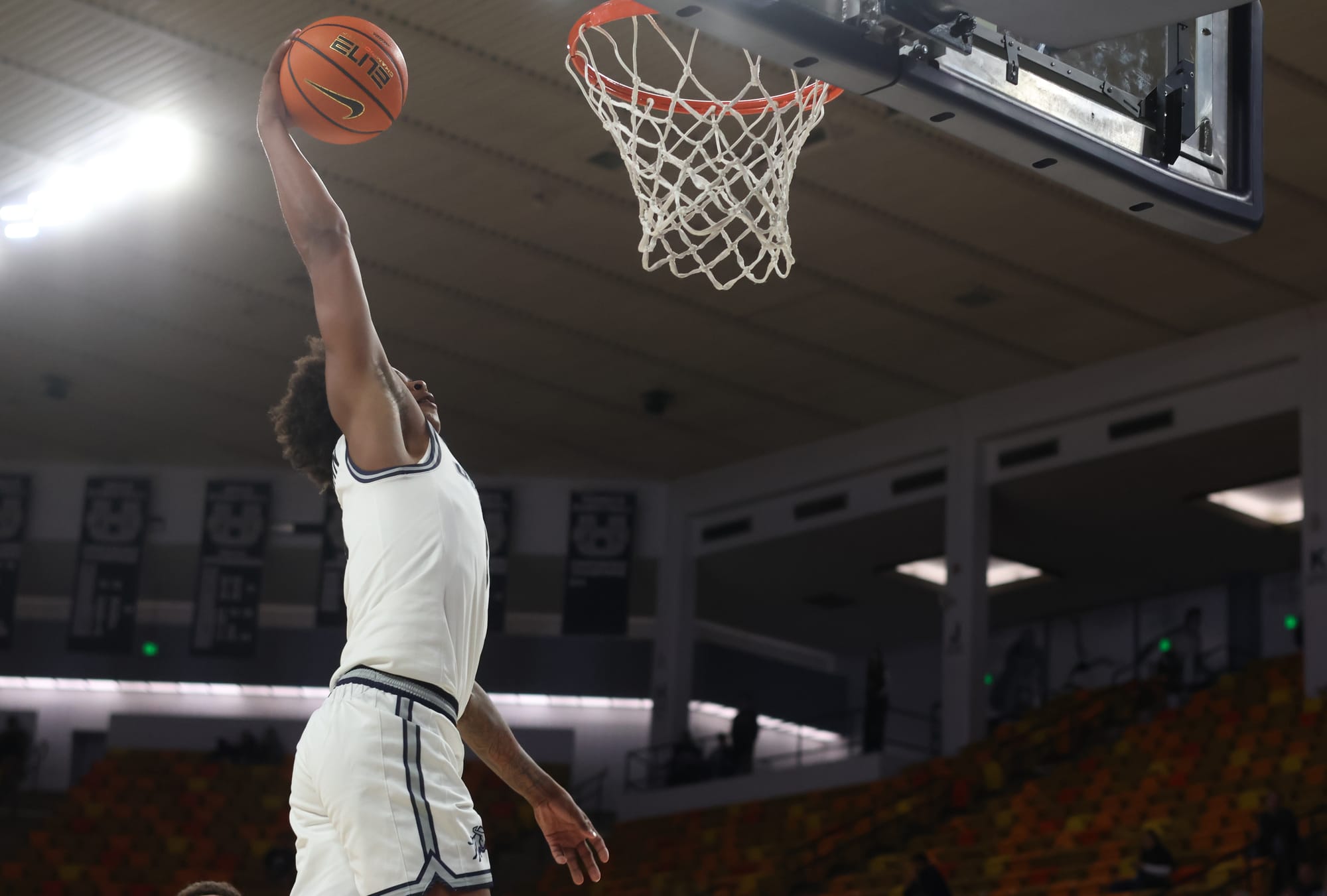
Perryman, who was Utah State's most impressive freshman on the day, chipped in four points, two assists, two steals and one rebound with one turnover in this additional period. Barnes and Boe both knocked down three-pointers without adding any other stats, while Clark and Iweze scored two points each to round out the Aggie scoring. Clark added an assist and a turnover, and Iweze pitched in three steals, two assists, two turnovers and a rebound. Closing out the lineup, Tosi did not attempt any shots, but he did grab a team-high four rebounds. Kearney was called for a foul and recorded no other stats.
"I thought Luke really struggled tonight but he'll get there," Calhoun said. "He has to play to his strengths. This is a totally different system than Air Force's with all of the cutting and different things."
Aggie Of The Game
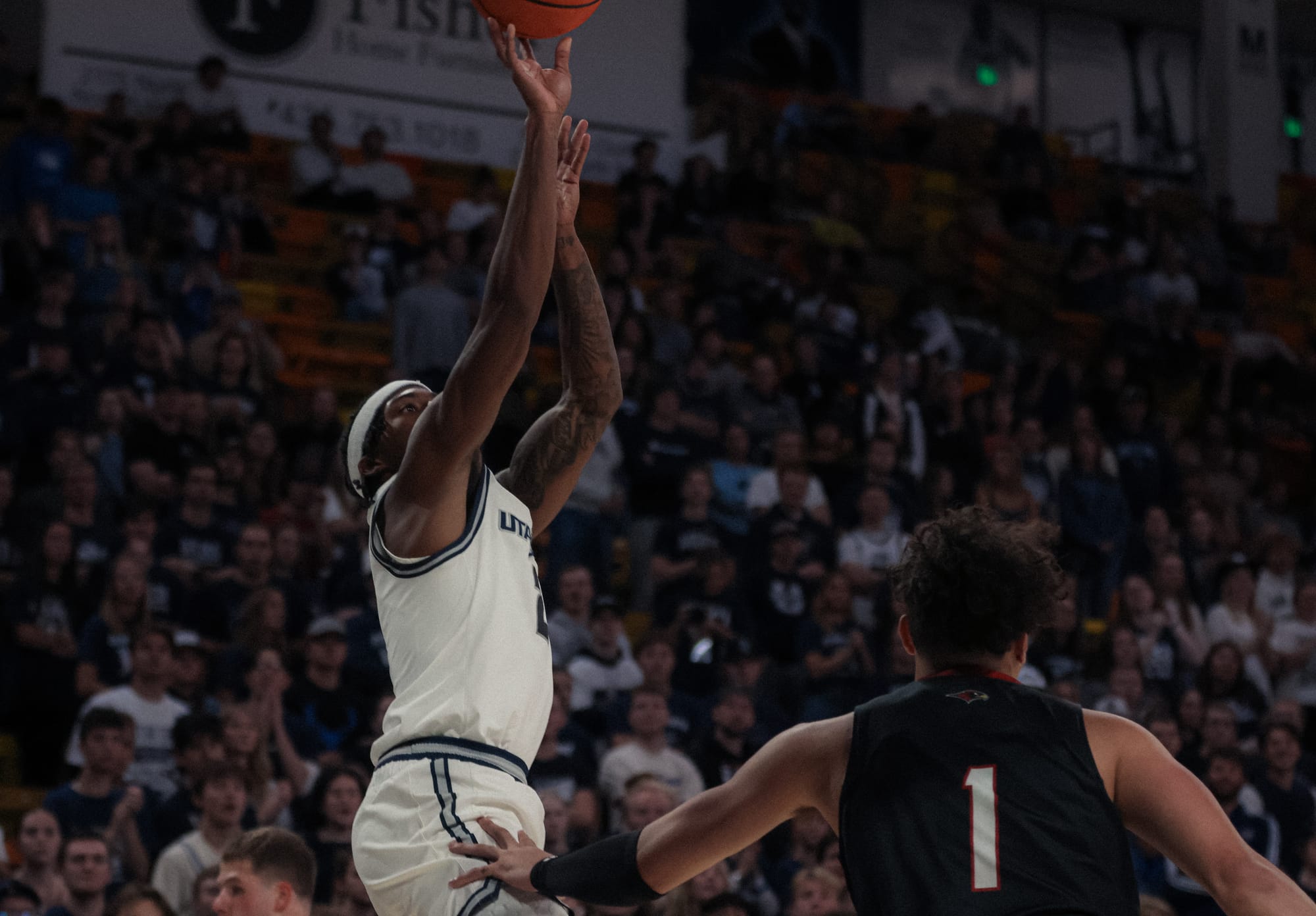
Collins, a senior out of Clover, South Carolina, looked right at home in Utah State's offense during the vast majority of his 25:40 spent on the floor. While the Aggies haven't dedicated much of any offseason time toward developing said offense, Collins found and knocked down the type of shots Calhoun wants to see from him, hitting 5 of 7 tries from the field and 2 of 3 from deep with three more points on four free throws.
"It's an interesting deal every year when you start getting these guys out of the portal and trying to figure out how to match them," Calhoun said. "The nice thing is they like each other. That's important and that's our culture, we over me. They understand the brotherhood here and the expectations of Utah State. Guys like MJ I think have really bought in, he's watching a lot of extra tape."
It was not a perfect debut for Collins, highlighted best by his team-high three turnovers, but his non-scoring impact was generally solid. He logged a pair of assists, matched Anderson and Falslev with a team-high three steals, grabbed a rebound and was called for only one foul, despite playing consistently aggressive defense.
"It's just slowing down a little bit," Collins said. "I can even say for myself, trying to go too fast and get to the next advantage, as coach instills in us every day. Basically it's just slowing down and seeing the game. Although we're playing fast, when your mind is slowing down, you can see everything much clearer. I feel like we've done a decent job of that today. Like coach said, we haven't really put in anything offensively. It's just sticking to certain concepts he has taught us and playing out of that.
"We watched film heavily on (Seattle). We knew that they pretty much help strong from the weak side. It was about getting downhill and skipping it to the corner. We knew we'd have wide-open threes, and a lot of them closed out hard, so we got the one-more (pass). This team, we have great shooters, and we made the game simple tonight from three. Taking the good ones, we'll make 50 percent of those."
As for his first experience in the Spectrum, albeit a diminished version of it compared to what awaits Utah State in less than two weeks when Westminster comes to town, Collins enjoyed himself greatly. He's long had the reputation of a player who feeds on crowd energy, and like with Calhoun's wide-open offense, he should have no trouble at all acclimating to his new home gym.
"It felt really good," Collins said. "I'm of course happy to be here and I really can't wait until the Spec is filled up 100 percent. For the first exhibition, it was pretty mind-blowing.
"I loved (the HURD). One of the guys came up to me before the game and he was like, 'When they call your name, we need a celebration for you.' I'm looking at him like, 'What do you mean?' I had to come up with a signature celebration that I guess they'll do every game. It was exciting. Of course I read and heard that it wasn't going to be that packed, but seeing them show up and show out for us, it really means a lot to me."
Lineup Notes
I have to do a disclaimer at the top here: These are not official lineup notes. I have put these together by hand through the play-by-play data available. Accordingly, they likely will not be perfect, and they are nowhere near as detailed as traditional lineup statistics, because I do not want to manually track assist rates and offensive rebound rates and things of that nature.
With that said, we have 26 different lineups to sort through. As far as I can tell, Utah State re-used a lineup only once in the entire exhibition, breaking out the Allen/Falslev/Collins/Anderson/Keller grouping to begin the game and turning to it again early in the second half. That lineup easily led the way with 4:37 minutes played, accounting for an 11-11 tie on the scoreboard. Utah State's most productive lineup on that front was the grouping of Perryman, King, Collins, Clark and Templin, which was plus-9 (11-2) in 3:23.
The easiest way to view the other 24 lineups is probably through specific player pairings, because Utah State tried almost every configuration it could reasonably think of. Allen was called upon the most at point guard, featuring in 11 unique lineups. His most common running mate at shooting guard was easily Falslev – they played more than 13 minutes together just in that configuration, building a 32-27 edge on the scoreboard with a 123.1 offensive rating (points per 100 possessions) and a 103.8 rating defensively. Allen also spent 3:40 with King as his shooting guard (163.6 offensive rating/127.3 defensive rating) and 2:29 with Collins (50.0/125.0). Barnes, meanwhile, ran almost exclusively with King (7:03 played, 104.3/130.4) while Perryman was similarly connected to the Butler transfer (9:19, 121.1/84.2), though he did spend a bit of time alongside Collins (2:58, 200.0/120.0) as well.
As for the off-ball guard/wing configurations, we need to set a standard first to keep everything organized. For the purposes of this exercise, I'm classifying Clark, Keller, Iweze and Templin as forwards and will get to them shortly. I've already picked out the point guards, Allen, Barnes and Perryman. That leaves Anderson, Boe, Collins, Elamin, Falslev, Kearney, King and Tosi as de facto guards or wings. Given that Boe, Elamin, Kearney and Tosi all played relatively sparse roles, I'll focus on Anderson, Collins, Falslev and King here.
- Anderson played exclusively at the power forward position, meaning he participated in no two-big lineups, because we aren't considering him a big. He spent all but two minutes of his 16:30 on the floor with Allen as his point guard (112.7/116.4) and 12:20 with Falslev as his shooting guard (104.0/96.0). Utah State didn't pair Anderson up with Collins at small forward quite as frequently, but that duo still accounted for 11:19 together and was Anderson's most common wing partnership (97.9/85.1). And at center, though Anderson played the majority of his time alongside Keller (8:25, 102.9/97.1), his most effective pairing was actually with Iweze (160.0/60.0) in a little under three minutes of action together.
- Collins was one of a few Aggies to split his time between two spots, logging 20:13 at small forward (120.5/79.5) and 5:27 at shooting guard (133.3/122.2). Considering that all of the latter roles came alongside Boe or Tosi, the former is probably more predictive of things to come. As a small forward, Collins logged 12:49 next to Falslev at SG (105.9/90.2) and 7:24 with King (148.1/59.3). His most common PF was Anderson, as noted above, though he did play briefly with Clark, Elamin and Kearney as well. His center pairing was almost dead even between Keller (6:48, 83.9/71.0) and Templin (7:33, 177.8/51.9), trailed by 3:37 with Iweze (107.7/92.3).
- The next most common small forward was Falslev, who occupied that spot only when King was on the floor at shooting guard. Those two spent 9:04 together (165.5/117.2) in that alignment. Across his 23:35 in total, Falslev played most often with Keller at center (8:10, 97.1/97.1), followed by Templin (7:15, 161.9/95.2), Clark (4:07, 133.3/146.7) and Iweze (4:03, 160.0/80.0).
- I've pretty well covered King already through these first three, but his most common center pairing was easily Templin, checking in at 12:08 (116.3/65.1).
And in the frontcourt, Utah State deployed only three two-big lineups, all of which featured Templin at center and Clark at power forward, contributing 8:08. Given that those minutes gave Utah State a 27-9 edge on the scoreboard with a preposterous 192.9 offensive rating and a similarly absurd 64.3 defensive rating, I'd expect to see those two together a lot this year.
"It's been different, and I've lost a lot of sleep over the last two or three weeks," Calhoun said. "Organically one day at practice, we came up with this little formula for our forwards and it was pretty good. We had some quick-hitting actions to get the ball inside. If we can't get it inside, we'll play out of pick-and-rolls or flares. It's interesting. Every team presents different challenges. Last year, we played a little more four-around-one. This year we'll play four-around-one, but at times we may be three-around-two where we're really trying to get the ball inside."
Finally, I have cumulative offensive and defensive ratings for every player, which are much easier to view through this screenshot than they would be in written form. The plus-minus numbers differ slightly here from the box score because I've attributed free throws after substitutions to the lineup that was on the floor when the foul was committed, not the one that entered the game after the stoppage of play:

Asked And Answered
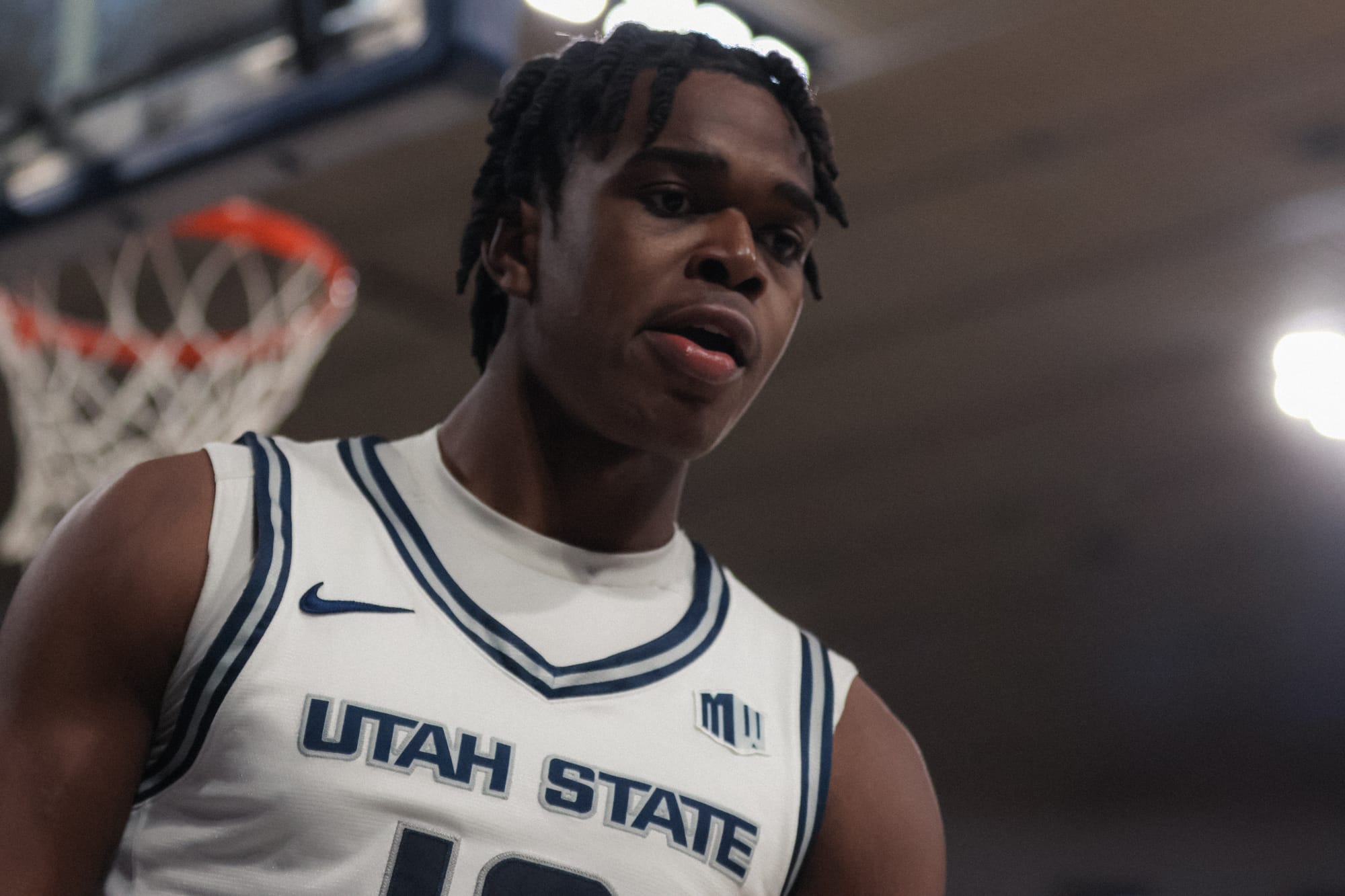
"What do you project as the starting lineup for this year's team? Also which freshman if any do you think will have the biggest role this season?" - Anon
I'll start with the starting lineup question. My guess right now, given that it was the first five in this outing and the only lineup Utah State used more than once, is that the Aggies will go with Allen/Falslev/Collins/Anderson/Keller to open games. I'd expect Calhoun to roll that center spot pretty heavily, as he did a season ago, with Templin serving as the first man off the bench and likely the overall leader in center minutes.
As for the freshmen, this exhibition did alter my outlook a bit, specifically on Perryman. He was the most involved of the bunch and seemingly the most prepared for action, and I would be very surprised if Utah State can keep him off the floor. He provides a very different skill set from Allen and Barnes, and if the Aggies intend to use King only as a secondary ball-handler like they did on Saturday, they'll need that change of pace from the freshman.
Elamin and Iweze are a little harder to project because we didn't see quite as much of them in this outing, but I'd expect both will have a role to play this season as well. Iweze is the best athlete in this frontcourt by a fairly wide margin, and while he's still very raw, I have to think his presence will be valuable enough to keep him away from a redshirt. Elamin is the wildcard. He's another freaky athlete, and I feel pretty good about his ability to keep up defensively, but his offense is not especially developed at this early stage, and he's still so skinny. I could really go either way on his availibility this season. It might depend on what Utah State feels it can get from Anderson, Clark and Kearney as stretch four options.
Rounding out the quintet, I'm expecting that both Boe and Tosi will redshirt this season. Both play in positions of strength for this roster, and with so many difficult decisions to make in cutting down this rotation, I'd bet that Utah State will gladly take a few easier calls and give those two a year to develop behind the scenes.
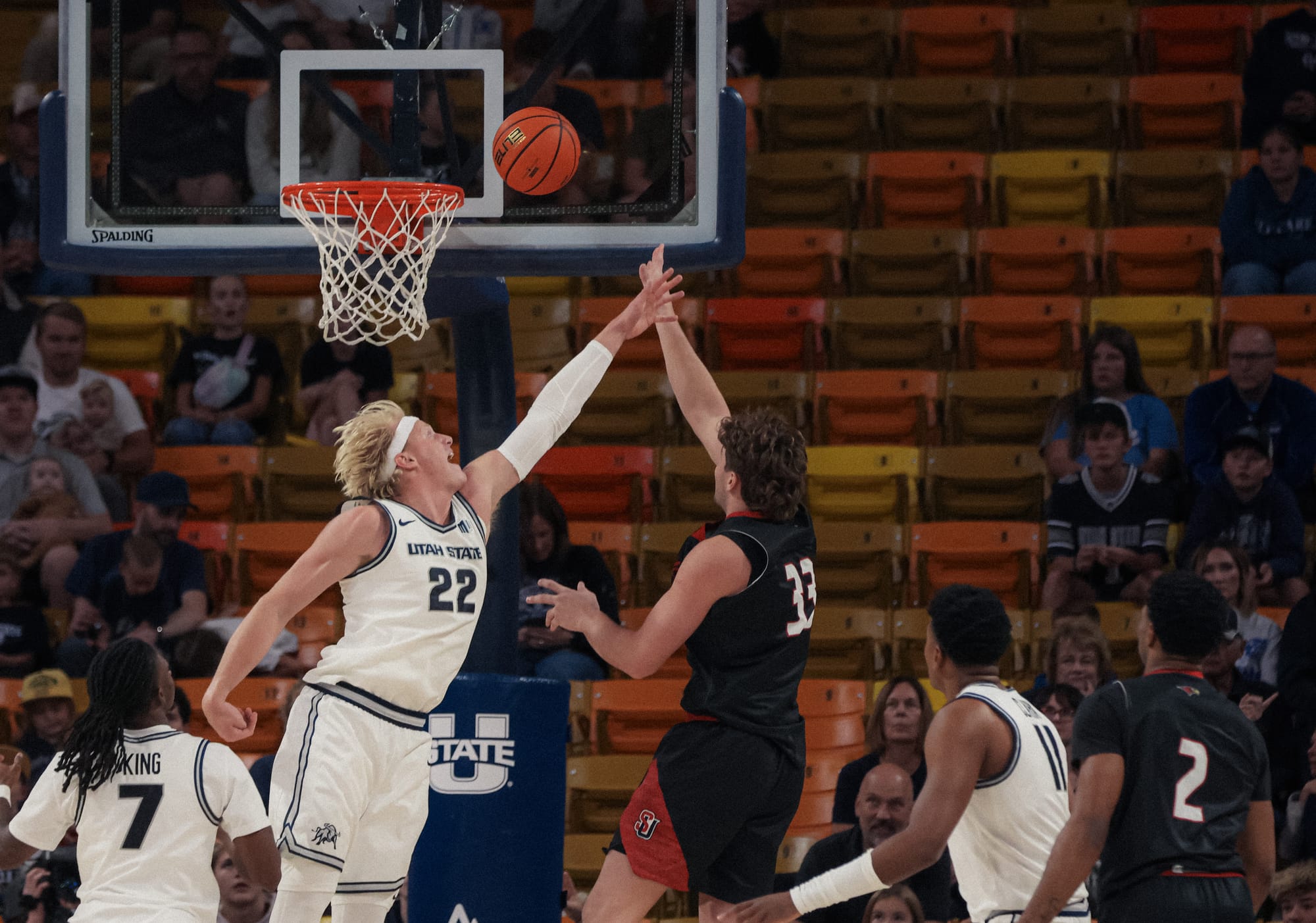
"During the exhibition, the other team seemed to score over Utah State’s big guys with ease at times. How big of a problem is it going to be during the season to lack a true shot blocker in the middle?" - @jasonneering
It was a point of consistent frustration last season, and if I'm being honest, I doubt that will really change this time around. Utah State's matchup zone defense, which is still the primary look on that end of the floor, is designed to function without a true shot blocker in the middle. The idea is to deny entry passes and penetration into the paint and to remove threats at the rim before they can develop.
That can only happen, however, when the players filling the zone are long enough to deny and deflect entry passes, and quick enough to prevent dribble penetration from the backcourt. Utah State wants to create turnovers when opponents try to attack the paint, and redirect the offensive focus toward jumpers, either from beyond the arc or, ideally, in the mid-range game. Each of Haut's last three defenses at NKU allowed a three-point attempt rate at or above 38 percent, and those three units ranked 36th, 11th and 35th in turnover percentage, respectively.
Last year, the Aggies lacked the length and quickness to pull that off, especially as fatigue set in down the stretch. They feel they've alleviated that with the newcomers added to the roster, and they're going to give the matchup zone another shot with those newcomers in the mix. If it works, there shouldn't be a need for that pure shot-blocking presence, because there won't be that many shots to actually block. If it's still failing to get the job done, however, you may see a shift in approach toward more lineups with Keller or Iweze in the middle – but it won't happen right away. Calhoun and Co. are committed enough to this system to try it again with talent better suited to it, and they're not going to throw that out unless it proves inoperable.
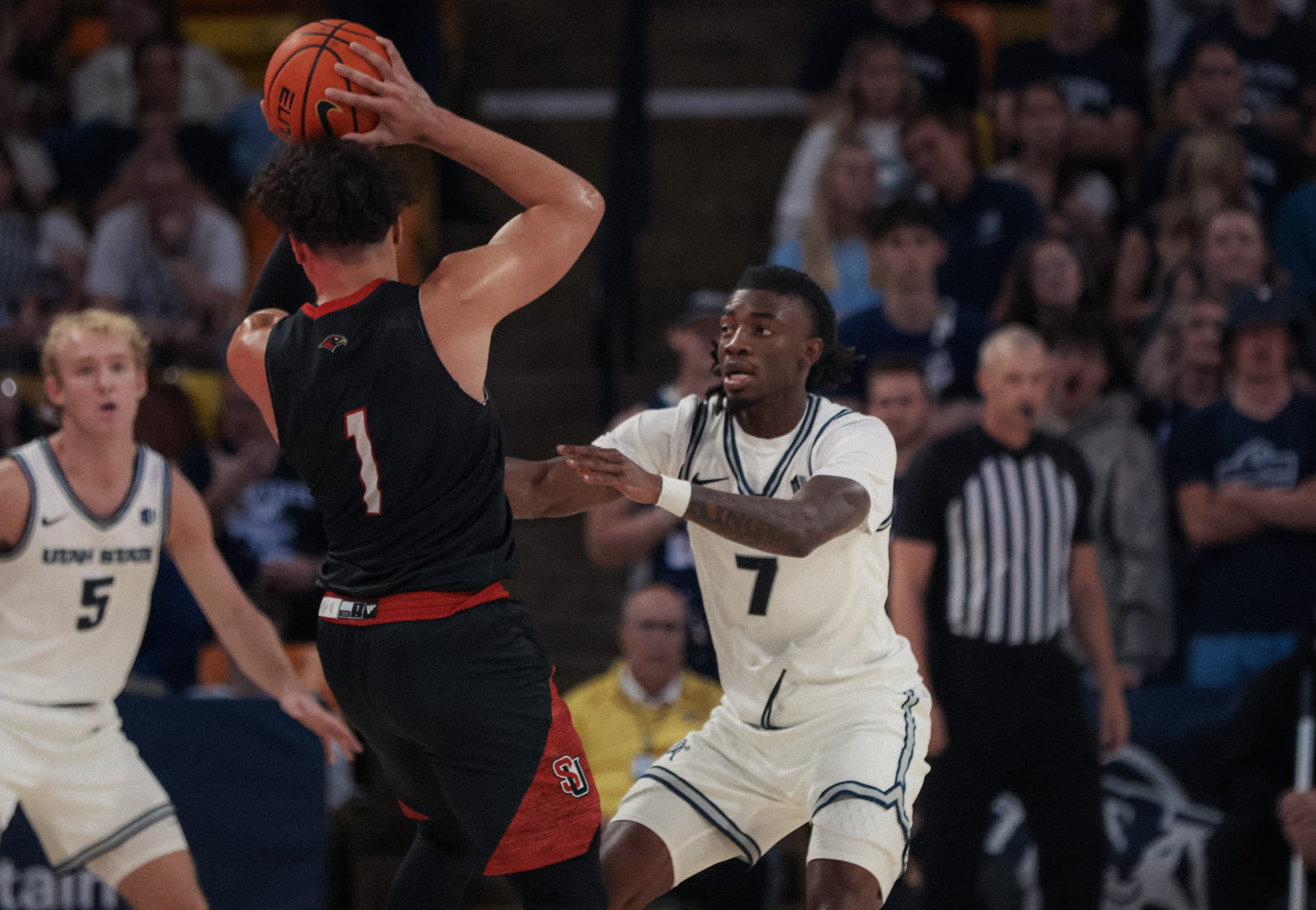
"After watching the exhibition, who’s on your radar for the player that might exceed their current expectations?" - @brittonfine
There are a lot of solid answers here, but many of them (Anderson, Clark, Collins, Iweze, Perryman) feel a little too obvious, so I'll go with King. He had an outstanding second half for the Aggies on Saturday, and I've been a big fan of his work since putting together the scouting report on him back in April.
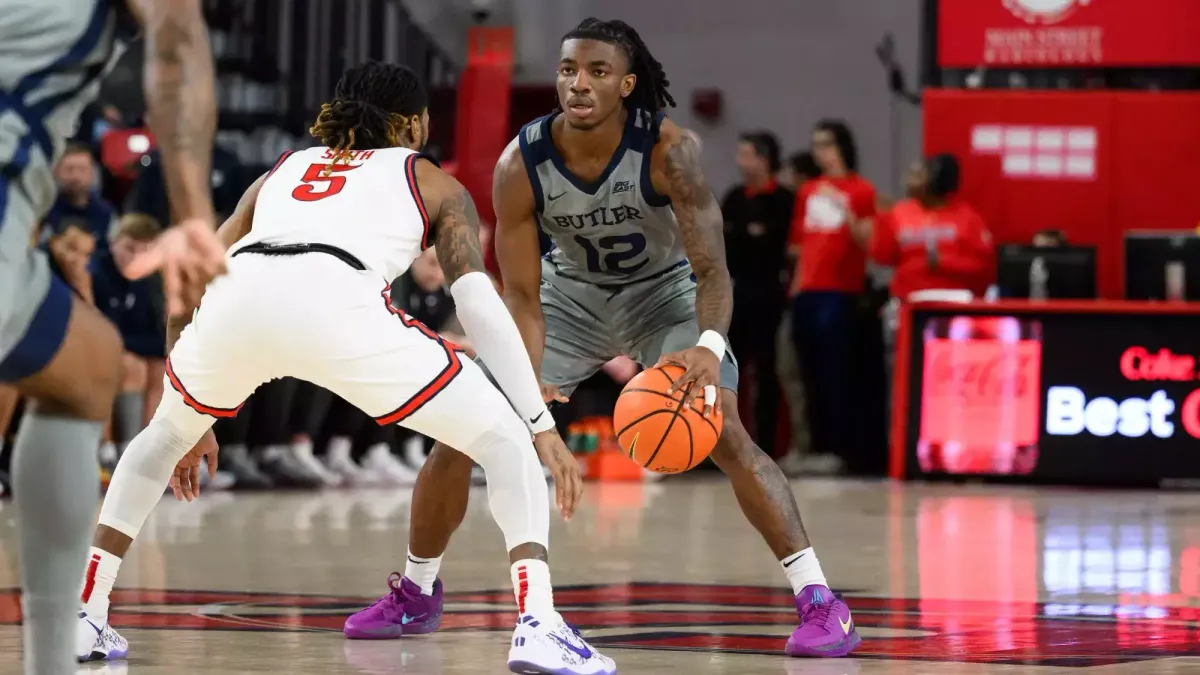
I'm expecting that he'll fill a role similar to the one Albury held a season ago, albeit as more of an off-ball guard than a true point guard. Like Albury, King is an athletic anomaly, albeit as a jumper rather than a sprinter, and I love the rebounding boost he can provide from the backcourt. From that scouting report:
"He's an extraordinary rebounder for his size and was one of only five high-major players to claim a defensive rebounding rate above 13 percent while standing 6-2 or shorter – a mark he easily surpassed last season at 19.4 percent, four percentage points clear of the next leader (Deivon Smith) and second only to Cal State Fullerton's Donovan Oday (19.5 percent) among players 6-2 and under in all DI conferences."
It may take him a little while to find consistency in this new system, especially on offense, but I think he'll be among Utah State's five best players by the end of the season, and that would certainly count as exceeding expectations.
